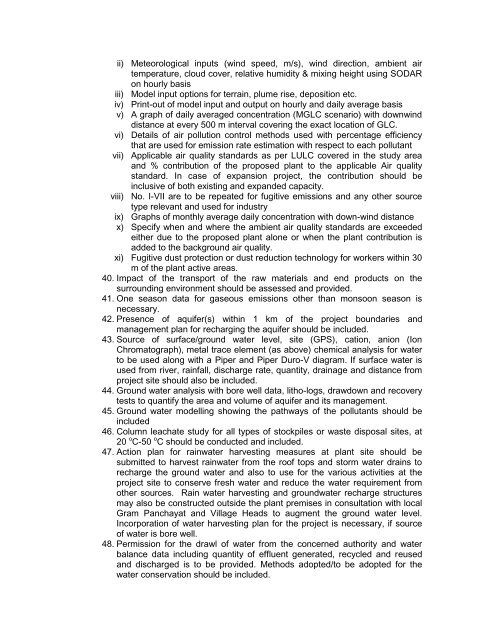MINUTES OF2ND RECONSTITUTED EXPERT APPRAISAL ...
MINUTES OF2ND RECONSTITUTED EXPERT APPRAISAL ...
MINUTES OF2ND RECONSTITUTED EXPERT APPRAISAL ...
- No tags were found...
Create successful ePaper yourself
Turn your PDF publications into a flip-book with our unique Google optimized e-Paper software.
ii) Meteorological inputs (wind speed, m/s), wind direction, ambient airtemperature, cloud cover, relative humidity & mixing height using SODARon hourly basisiii) Model input options for terrain, plume rise, deposition etc.iv) Print-out of model input and output on hourly and daily average basisv) A graph of daily averaged concentration (MGLC scenario) with downwinddistance at every 500 m interval covering the exact location of GLC.vi) Details of air pollution control methods used with percentage efficiencythat are used for emission rate estimation with respect to each pollutantvii) Applicable air quality standards as per LULC covered in the study areaand % contribution of the proposed plant to the applicable Air qualitystandard. In case of expansion project, the contribution should beinclusive of both existing and expanded capacity.viii) No. I-VII are to be repeated for fugitive emissions and any other sourcetype relevant and used for industryix) Graphs of monthly average daily concentration with down-wind distancex) Specify when and where the ambient air quality standards are exceededeither due to the proposed plant alone or when the plant contribution isadded to the background air quality.xi) Fugitive dust protection or dust reduction technology for workers within 30m of the plant active areas.40. Impact of the transport of the raw materials and end products on thesurrounding environment should be assessed and provided.41. One season data for gaseous emissions other than monsoon season isnecessary.42. Presence of aquifer(s) within 1 km of the project boundaries andmanagement plan for recharging the aquifer should be included.43. Source of surface/ground water level, site (GPS), cation, anion (IonChromatograph), metal trace element (as above) chemical analysis for waterto be used along with a Piper and Piper Duro-V diagram. If surface water isused from river, rainfall, discharge rate, quantity, drainage and distance fromproject site should also be included.44. Ground water analysis with bore well data, litho-logs, drawdown and recoverytests to quantify the area and volume of aquifer and its management.45. Ground water modelling showing the pathways of the pollutants should beincluded46. Column leachate study for all types of stockpiles or waste disposal sites, at20 o C-50 o C should be conducted and included.47. Action plan for rainwater harvesting measures at plant site should besubmitted to harvest rainwater from the roof tops and storm water drains torecharge the ground water and also to use for the various activities at theproject site to conserve fresh water and reduce the water requirement fromother sources. Rain water harvesting and groundwater recharge structuresmay also be constructed outside the plant premises in consultation with localGram Panchayat and Village Heads to augment the ground water level.Incorporation of water harvesting plan for the project is necessary, if sourceof water is bore well.48. Permission for the drawl of water from the concerned authority and waterbalance data including quantity of effluent generated, recycled and reusedand discharged is to be provided. Methods adopted/to be adopted for thewater conservation should be included.
















